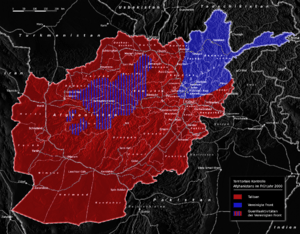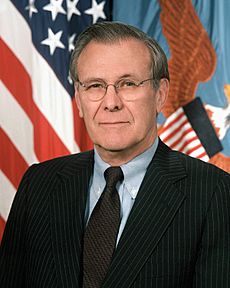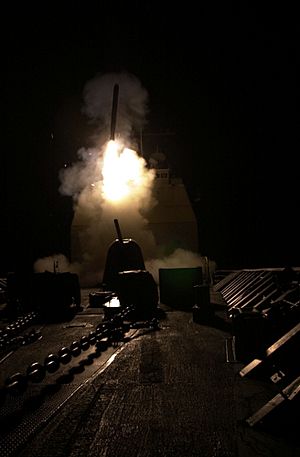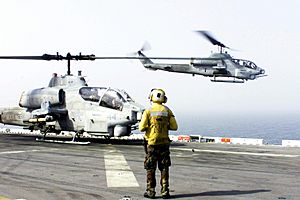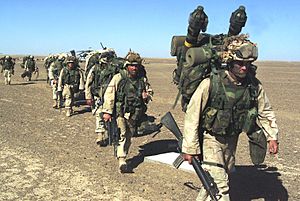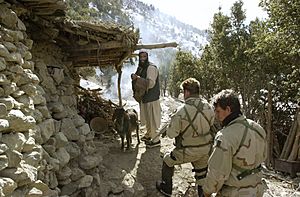United States invasion of Afghanistan facts for kids
Quick facts for kids United States invasion of Afghanistan |
|||||||
|---|---|---|---|---|---|---|---|
| Part of War in Afghanistan and the War on terror | |||||||
 Map of the main operations of the United States special forces from October 2001 to March 2002 |
|||||||
|
|||||||
| Belligerents | |||||||
|
|
|
||||||
| Commanders and leaders | |||||||
| Strength | |||||||
|
|
||||||
| Casualties and losses | |||||||
|
|
||||||
| 1,537 to 2,375 Afghan civilians killed | |||||||
In late 2001, the United States and its allies invaded Afghanistan. They wanted to remove the Taliban government from power. The main goals were to stop al-Qaeda, which was responsible for the September 11 attacks, and to prevent them from using Afghanistan as a safe place to plan more attacks. The United Kingdom was a very important ally, supporting the US from the start.
This invasion happened after a civil war in Afghanistan (1996–2001). In that war, the Taliban had taken control of most of the country. The invasion became the first part of a 20-year conflict called the War in Afghanistan. It also marked the start of America's War on Terror.
After the September 11 attacks, US President George W. Bush demanded that the Taliban hand over Osama bin Laden. Bin Laden was the leader of al-Qaeda. The Taliban refused to give him up and ignored demands to close terrorist bases. So, the US and UK launched Operation Enduring Freedom on October 7, 2001. Other forces, like the Northern Alliance, joined them later.
The US and its allies quickly removed the Taliban from power by December 17, 2001. They built military bases across Afghanistan. However, many al-Qaeda and Taliban members escaped. They went to neighboring Pakistan or hid in mountains during the Battle of Tora Bora.
In December 2001, the United Nations Security Council created the International Security Assistance Force (ISAF). This group helped with military operations and trained Afghan security forces. At a meeting in Germany, Hamid Karzai was chosen to lead a new Afghan government. But in 2002, the Taliban leader Mullah Omar started a new fight against the government and ISAF. In 2021, the Taliban took control of Afghanistan again as international forces left.
Contents
- Understanding the Conflict's History
- The Path to Invasion
- Removing the Taliban Government
- Military Leadership
- First Steps
- Early Air Strikes
- Operations Rhino and Gecko
- Continued Air Strikes and Advances
- The Fall of Mazar-i-Sharif
- The Fall of Kabul
- Operations Wolverine, Raptor, and Relentless Strike
- The Battle of Tarinkot
- The Fall of Kunduz
- Operation Trent
- The Battle of Qala-i-Jangi
- Taking Kandahar
- The Battle of Tora Bora
- New Government in Afghanistan
- Impact and Aftermath
- Supplies and Bases
- Legality of the Invasion
- Reactions and What Happened Next
- See also
Understanding the Conflict's History
In 2001, Afghanistan had been at war for over 20 years. In 1978, a communist party took power. This led to a popular uprising. The Soviet Union stepped in to support the government in 1979. This made the US and Saudi Arabia support rebels fighting against the Soviets. These rebels were called mujahideen.

After the Soviet army left Afghanistan in 1989, the communist government fell in 1992. Different mujahideen leaders then fought each other in a civil war from 1992 to 1996. Osama bin Laden had left the country by then. The US also lost interest in Afghanistan.
In 1994, a mujahid named Mullah Omar started the Taliban movement. His followers were religious students. They wanted to end the fighting by following strict Islamic law. By the end of 1994, the Taliban had taken control of Kandahar Province.
Taliban Rule and the Northern Alliance (1996–2001)
In 1996, the Taliban took over Kabul, Afghanistan's capital. They formed the Islamic Emirate of Afghanistan. They put in place very strict rules based on their understanding of Islam. For example, women were not allowed to work or go to school. They also had to follow strict rules about veiling.
After the Taliban took Kabul, Ahmad Shah Massoud formed a group called the Northern Alliance. This group fought against the Taliban. The Northern Alliance included different ethnic groups like Tajiks, Uzbeks, and Hazaras. Russia, Iran, and India supported them. By 2001, the Taliban controlled 80% of Afghanistan. The Northern Alliance held only a small part in the northeast.
Al-Qaeda's Presence
Osama bin Laden moved to Afghanistan in 1996. He had started al-Qaeda in the late 1980s. He became very close with the Taliban. However, in 2000, Mullah Omar told bin Laden not to attack the United States while he was in Afghanistan.
In the 1990s, the US planned several times to capture or kill bin Laden. But President Bill Clinton never gave the order.
Changes in US Policy
The US policy towards Afghanistan changed after the 1998 US embassy bombings. Al-Qaeda was behind these attacks. President Clinton ordered missile strikes on al-Qaeda training camps in Afghanistan. In 1999, the US and the United Nations put rules in place against the Taliban. They demanded the Taliban hand over bin Laden and close all terrorist bases.
In September 2001, the US decided to support groups fighting the Taliban. They planned to tell the Taliban to hand over bin Laden. If the Taliban refused, the US would help anti-Taliban groups try to overthrow them.
Afghanistan Before 9/11
On September 9, 2001, two al-Qaeda members killed Ahmad Shah Massoud. He was the leader of the Northern Alliance. This made it seem like the Taliban would soon control all of Afghanistan. Mohammed Fahim became the new Northern Alliance leader. The Alliance had about 15,000 to 20,000 fighters.
The Taliban had about 45,000 Afghan fighters and 2,700 foreign fighters. This included al-Qaeda's 055 Brigade. Hundreds of officers from Pakistan's intelligence service also advised the Taliban. By mid-October, about 10,000 Pakistani volunteers, some as young as 14, joined the Taliban.
Both sides used mostly Russian military equipment. They both had a history of bad actions during the war. Also, Afghanistan faced a serious problem with drought in 2001. Millions of Afghans needed food aid.
The Path to Invasion
On September 11, 2001, al-Qaeda attacked the United States. They used four hijacked airplanes. Nearly 3,000 people died. The CIA quickly confirmed al-Qaeda was responsible. The Taliban said they did not support the attacks and denied bin Laden's involvement. Bin Laden himself first denied it, but later took responsibility in 2004. One of bin Laden's goals was to draw the US into a costly war in Afghanistan. He hoped the US would be defeated, just like the Soviet Union had been.
Diplomacy and Politics

On September 11, President Bush said the US would respond. He stated they would treat those who planned the attacks and those who helped them the same. On September 14, Congress allowed military force against al-Qaeda and its supporters. On September 20, President Bush told the Taliban to hand over bin Laden or face war.

Afghan religious leaders met and suggested the Taliban ask bin Laden to leave. But they also warned that if the US invaded, fighting back would be necessary. On September 21, Mullah Omar refused Bush's demands. He again denied bin Laden was responsible for 9/11.
The Taliban did try to negotiate about bin Laden. But they could not agree. On October 4, the British government showed evidence linking bin Laden to the attacks. That same day, NATO (North Atlantic Treaty Organization) used Article V for the first time. This rule means an attack on one member is an attack on all. On October 7, as US bombing began, President Bush said, "Full warning has been given, and time is running out."
Planning the Attack
In 2001, the US military did not have a plan for invading Afghanistan. So, the CIA created a plan. It used parts of their old plans to work with the Northern Alliance against the Taliban. President Bush and his team met on September 15 to plan the war. The military offered three options. The CIA also presented its plan. It involved sending special teams to work with the Northern Alliance and US Special Forces. The goal was to use as few American ground troops as possible. This was to avoid making Afghans angry, as the British and Russians had done before.
The military finished its plan by September 21. They called it Operation Infinite Justice. This name was changed to Operation Enduring Freedom. This was because "Infinite Justice" was seen as culturally insensitive.
The US wanted to destroy al-Qaeda and remove the Taliban. But they also wanted to stop the Northern Alliance from taking over all of Afghanistan. They thought this would upset the Pashtun people, who were the majority.
Humanitarian Situation in Afghanistan
Before the invasion, life in Afghanistan was very hard. Thousands of Afghans tried to flee because they feared US military action. This was on top of millions who were already refugees from 22 years of conflict. Food was running low, and most aid workers had left. One reporter described Afghanistan as a "post-apocalyptic place." In 2001, 70% of the people were not getting enough food.
| Afghan Refugees by Country (September 2001) | |
|---|---|
| 2,000,000 | |
| 1,400,000 | |
| 30,000 | |
News reports suggested that millions of Afghans could starve. This was because aid was stopped, borders were closed, and winter was coming. The UN feared the crisis could become as bad as those in Bosnia and Rwanda.
Removing the Taliban Government
Military Leadership
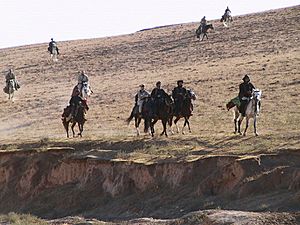
The invasion involved American, British, Canadian, and Australian forces. Other countries helped with supplies. General Tommy Franks was the overall commander for the US operation. He led several special groups. These groups included special forces teams and conventional military units. Their goals were to capture or kill al-Qaeda and Taliban leaders. They also gathered information and helped with humanitarian efforts.
First Steps
On September 26, 2001, the US secretly sent 10 CIA members into Afghanistan. They went to the Panjshir Valley, a Northern Alliance stronghold. This team, called 'Jawbreaker', brought $3 million to buy support. They met with General Mohammed Fahim, a Northern Alliance commander. They also prepared for the arrival of US Army Special Forces. The team brought satellite equipment to send intelligence reports. They also fixed an old airstrip for planes to land.
On September 28, British intelligence officers also arrived in Afghanistan. They worked to build alliances and convince Taliban commanders to switch sides. Two more CIA teams arrived near other Afghan cities.
Early Air Strikes
On October 7, the US began military actions in Afghanistan with air strikes. They hit 31 targets across the country. Most of the Taliban's old air defense systems and planes were destroyed on the first night. The CIA also used a Predator drone for the first time in an attack. This marked the start of a new way of fighting with drones.
Over the next few days, US aircraft bombed Taliban training camps and air defenses. US Navy ships and British submarines launched missiles. Within days, most Taliban training sites were badly damaged. The US dropped 1500 bombs in the first week. They also started dropping food and medical supplies to civilians. By the second week, most planned targets were destroyed.
On October 19, US Army Green Beret teams were flown into Afghanistan by helicopter. They went to work with the Northern Alliance commanders. British Special Air Service (SAS) troops also deployed for reconnaissance missions.
Operations Rhino and Gecko
On the night of October 19, 200 Rangers from the US Army parachuted onto a landing strip south of Kandahar. This was called Objective Rhino. They secured the area so planes could refuel. Two Rangers died when their helicopter crashed in Pakistan while supporting this mission.
At the same time, Delta Force soldiers attacked Mullah Omar's home outside Kandahar. This was Objective Gecko. They found no resistance and no sign of the Taliban leader. They searched for intelligence. The Pentagon later showed videos of these operations to the news.
Continued Air Strikes and Advances
The Green Berets worked with General Abdul Rashid Dostum to plan an attack on Mazar-i-Sharif. They guided in the first Joint Direct Attack Munition bomb from a B-52 bomber. The Americans also broadcast radio messages in local languages. They called al-Qaeda and the Taliban criminals. They offered $25 million for information leading to bin Laden.
On October 23, an anti-Taliban leader named Abdul Haq entered Afghanistan. He tried to start a revolt, but the Taliban captured and executed him.
By early November, US aircraft started attacking Taliban front lines. The constant air strikes began to have a big effect. The Taliban started to retreat towards Mazar-i-Sharif. Dostum's forces and the Green Berets followed them. On November 5, Dostum and General Mohammad Atta attacked the village of Baluch. A cavalry charge by Dostum's men, combined with a B-52 bomb, broke the Taliban defenses. They continued towards Mazar-i-Sharif.

Near Kabul, Green Berets guided in powerful "Daisy Cutter" bombs. These caused many Taliban casualties. Other Green Beret teams also entered Afghanistan to support different Northern Alliance commanders.
The Fall of Mazar-i-Sharif

Mazar-i-Sharif was an important city. It had a sacred Muslim site and was a transport hub. Taking the city would allow humanitarian aid to reach millions of people. Dostum and Atta fought their way to the city. They seized a key pass on November 9, causing the Taliban to retreat. The Northern Alliance entered the city on November 10.
The fall of Mazar-i-Sharif was a big surprise. US commanders thought it would stay in Taliban hands much longer. US teams immediately began helping with reconstruction.
On November 10, British Special Boat Service (SBS) operators landed at Bagram Airfield. This caused a problem with Northern Alliance leaders. They felt the British had not asked permission. The British government tried to smooth things over, but the deployment was put on hold.
On November 11, another Afghan general surprised the Americans. He launched a sudden attack on the city of Taloqan. The city fell before the first bomb could be dropped.
The Fall of Kabul
On November 12, the US tracked and killed al-Qaeda's third-highest leader, Mohammed Atef, with an air strike in Kabul. That day, the Taliban left Kabul. They planned to regroup in Jalalabad and Kandahar. Northern Alliance forces entered Kabul on November 13. During their retreat, the Taliban left some foreign aid workers in a prison. Anti-Taliban Afghans freed them. US Navy SEALs rescued them by helicopter on November 14.
The fall of Kabul led to a quick collapse of Taliban positions. Within 24 hours, all Afghan provinces along the Iranian border fell. Local commanders took over in northeastern Afghanistan. Taliban fighters in the north retreated to Kunduz. Others went to their main area around Kandahar.
Meanwhile, Delta Force soldiers parachuted near Kandahar. They called in air strikes on Taliban forces retreating from Kabul. By November 13, al-Qaeda and Taliban forces, possibly including bin Laden, were gathering in Tora Bora. This area had many caves and defenses. On November 16, the US began bombing Tora Bora.
Operations Wolverine, Raptor, and Relentless Strike
On November 13, US Rangers carried out another parachute drop. They secured a dry lake bed southwest of Kandahar. Helicopters were flown in and then attacked Taliban compounds. These were called Objective Wolverine and Objective Raptor. After the attacks, the helicopters flew back to Oman.
A few nights later, Operation Relentless Strike began. Rangers secured a desert airstrip. Helicopters then flew search and destroy missions along Highway 1. They continued these missions for several nights.
The Battle of Tarinkot
On November 14, a US Special Forces team and Hamid Karzai entered Uruzgan Province. Karzai was a Pashtun leader who opposed the Taliban. He had been extracted by the CIA earlier but returned. As Karzai's forces approached Tarinkot, the town's people revolted and drove out the Taliban. Karzai met with the town elders. The Taliban then gathered 300-500 men to retake the town. Karzai's small force, with US air support, managed to push the Taliban away.
This victory was very important for Karzai. He used it to recruit more fighters. His group grew to about 800 men. They then began moving towards Kandahar.
The Fall of Kunduz
US forces then focused on Kunduz, the last Taliban stronghold in the north. After 11 days of fighting and bombing, Taliban fighters surrendered on November 23. Before the surrender, Pakistani planes arrived. They evacuated intelligence and military personnel who had been helping the Taliban. This included some Taliban and al-Qaeda leaders. The details of this airlift are still debated.
Operation Trent
The British SAS had a small role in the early war. US commanders kept targets for their own units. British Prime Minister Tony Blair had to ask for the SAS to get a direct mission. This was to destroy an al-Qaeda facility southwest of Kandahar. The facility was defended by 80-100 foreign fighters. The SAS were ordered to attack in daylight because they would not get air support at night.
The mission began in November 2001. An 8-man SAS patrol parachuted into the desert to check a landing strip. The main assault force then landed in C-130 planes. They drove to the target in Land Rovers and dirt bikes. The attack began with an air strike. The SAS then moved in on foot. Four SAS operators were wounded. This was the largest British SAS operation in history.
The Battle of Qala-i-Jangi
On November 25, Taliban prisoners were moved into Qala-i-Jangi fortress near Mazar-i-Sharif. Some prisoners attacked their guards. This led to a revolt by 600 prisoners. They took control of part of the fortress, including a weapons storage area. Johnny Micheal Spann, a CIA officer, was killed. He was America's first combat death in the war.
Another CIA officer called for help. A quick reaction force arrived. It included Delta Force, Green Berets, and British SBS members. They fought the prisoners for four days. Green Berets called in many air strikes. During one strike, a bomb hit near friendly forces, wounding nine soldiers.
The battle ended on December 1 after seven days. Only 86 Taliban prisoners survived out of 1,000. Around 50 Northern Alliance soldiers were killed.
Taking Kandahar
ODA 574 and Hamid Karzai moved towards Kandahar. They gathered fighters from local Pashtun tribes. They fought the Taliban for two days at the Sayd-Aum-Kalay Bridge. With US airpower, they took the bridge, opening the road to Kandahar.
Another US Special Forces team supported Gul Agha Sherzai, the former governor of Kandahar. They called in fire on Taliban positions. By the end of November, Kandahar was the Taliban's last major stronghold. About 3,000 tribal fighters under Karzai and 350 under Sherzai pressured the Taliban.
Meanwhile, nearly 1,000 US Marines set up a base called Camp Rhino south of Kandahar. On November 26, Taliban armored vehicles approached the base. Helicopter gunships attacked and destroyed many of them.
On December 5, a large bomb accidentally landed among the Green Berets from ODA 574. Three members were killed, and the rest were wounded. Over 20 of Karzai's fighters also died. Karzai himself was slightly hurt. A Delta Force unit nearby helped the wounded.
On December 6, Karzai was told he would be the next president of Afghanistan. He also negotiated the surrender of the remaining Taliban forces and the city of Kandahar. On December 7, Sherzai's forces took Kandahar airport and moved into the city. Mullah Omar left Kandahar and disappeared. Other Taliban leaders fled to Pakistan.
In early December, 7,500 Taliban prisoners were moved from Kunduz to Sheberghan prison. Many suffocated in crowded trucks or were shot. This event is known as the Dasht-i-Leili massacre. A mass grave was found in 2002.
The Battle of Tora Bora
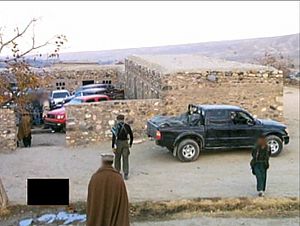
After Kabul and Kandahar fell, suspected al-Qaeda members, including bin Laden, went to Tora Bora. This area had a network of caves and defenses. US commanders decided to use US Special Forces to support local Afghan militias. They wanted to avoid sending many regular troops.
A US Special Forces team and a CIA team went to Tora Bora. They advised Afghan militias. The CIA team leader asked for US Rangers to block escape routes into Pakistan. But this request was denied.
The Afghan militias launched attacks, but with limited success. The battle happened during Ramadan, so fighters would retreat at night to eat. On December 9, Delta Force and British SBS operators joined the battle. They took over command. They also searched for bin Laden.
On December 12, one of the Afghan warlords negotiated a truce. This allowed many al-Qaeda and Taliban members to escape into Pakistan. Bin Laden is believed to have left Tora Bora that night. The battle ended on December 17.
US and UK forces continued searching the caves. But they found no sign of al-Qaeda leaders. About 220 al-Qaeda fighters were killed. No American or British soldiers died.
Later, the military was criticized for not sending more ground forces to capture bin Laden. Some believed the commander did not want to repeat the Soviet mistake of sending many troops. Others said there were not enough planes to move a large force.
New Government in Afghanistan
In late November 2001, the United Nations held a meeting in Germany. The Taliban were not invited. Three Afghan opposition groups took part. The meeting created the Afghan Interim Authority. This was a temporary government. It planned for a new constitution and a new Afghan government. After the meeting, tribal leaders and former exiles formed a temporary government in Kabul. Hamid Karzai led it.
Impact and Aftermath
Studies estimate that between 1,537 and 2,375 civilians died during the invasion. The number of Northern Alliance casualties is not known. The United States lost 12 military personnel and one CIA officer. The Taliban had between 8,000 and 12,000 killed. Some reports mentioned bad actions by the Northern Alliance against Pashtun villages.
Supplies and Bases
Afghanistan is a landlocked country with difficult mountains and weather. This makes military operations hard. Before the war, the US had no military bases in Central or South Asia. The first CIA team entered Afghanistan by helicopter from Uzbekistan.
The US set up its main base at Karshi-Khanabad Air Base in Uzbekistan. Pakistan also allowed the US to use two auxiliary air bases. The CIA flew Predator drones from these bases. An aircraft carrier in the Indian Ocean was used for helicopters. Some bombers flew from Diego Garcia, an island, or even directly from Missouri in the US.
Legality of the Invasion
Experts have debated if the invasion was legal under international law. The US and its allies said it was an act of self-defense. This is allowed by the United Nations Charter. The US told the UN that Afghanistan was helping terrorists who attacked the US. They said military action was needed to stop more attacks.
Some experts argued the invasion was not legal. They said al-Qaeda, not Afghanistan, attacked the US. They also said there was no proof of more immediate attacks. Other experts argued it was legal. They said Afghanistan was responsible for al-Qaeda's actions because it let them operate there.
Reactions and What Happened Next
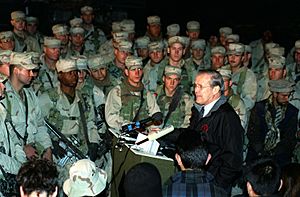
In October 2001, polls showed that most Americans (88%) and Britons (65%) supported the military action. Polls in other countries showed mixed reactions. Some countries supported it, while others opposed it. There were also protests against the invasion in cities like Washington, D.C., and London.
In Afghanistan, many people, especially non-Pashtuns, supported the US action. In November 2001, after the Taliban left Kabul, people felt relieved. Young men shaved their beards, and women took off their burqas.
On December 20, 2001, the United Nations allowed the International Security Assistance Force (ISAF). This force was to help keep security in Kabul. For its first years, ISAF had about 8,000 American and 5,000 other soldiers. Its mission was only around Kabul.
In February 2002, the US found many Taliban and al-Qaeda fighters in eastern Afghanistan. Coalition forces cleared the area in Operation Anaconda in March 2002. Eight US soldiers were killed, and 80 were wounded.
US forces set up their main base at Bagram airbase. Kandahar airport also became an important US base. Al-Qaeda and Taliban fighters then set up safe places on the Pakistani border. From there, they launched attacks into Afghanistan.
US Secretary of Defense Donald Rumsfeld wanted to finish operations quickly. He wanted to focus on fighting terrorists and building a new Afghan army. In mid-2002, Rumsfeld said, "The war is over in Afghanistan." This surprised many officials. As a result, the US did not plan for a large Afghan army.
In February 2002, the US decided not to expand ISAF beyond Kabul. This decision was later seen as a mistake. It allowed problems to grow within the Afghan government. The rise of the Taliban insurgency was linked to these problems.
Several events in early 2002 marked the end of the first phase of the war. These included the scattering of Taliban and al-Qaeda groups. Also, the US decided not to expand international forces. President Bush spoke about rebuilding Afghanistan. However, the US was also focusing more resources on the Iraq War. This made it hard to commit more resources to Afghanistan.
See also
 In Spanish: Invasión estadounidense de Afganistán para niños
In Spanish: Invasión estadounidense de Afganistán para niños


